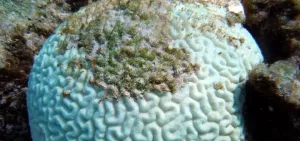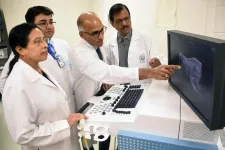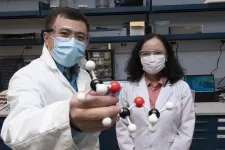(Press-News.org) The emergence of SARS-CoV-2 virus variants that are adding twists in the battle against COVID-19 highlight the need for better genomic monitoring of the virus, says Katia Koelle, associate professor of biology at Emory University.
"Improved genomic surveillance of SARS-CoV-2 across states would really help us to better understand how the virus causing the pandemic is evolving and spreading in the United States," Koelle says. "More federal funding is needed, along with centralized standards for sample collection and genetic sequencing. Researchers need access to such metadata to better track how the virus is spreading geographically, and to identify any new variants that may make it harder to control, so that health officials can respond more quickly and effectively."
Koelle studies the interplay between viral evolution and the epidemiological spread of viral infectious diseases. She is senior author of a "Viewpoint" article just published in the journal Science on the importance of SARS-CoV-2 sequencing to control the COVID-19 pandemic.
Michael Martin, a PhD student in Emory's Population, Biology and Ecology Program and a member of Koelle's lab, is first author of the Science article. David VanInsberghe, a post-doctoral fellow in Koelle's lab, is co-author.
"Research into SARS-CoV-2 has been going at lightning speed," Martin says. "This acceleration has provided us with one of the largest datasets ever so quickly assembled for a disease. We've learned a lot so far about how this virus spreads and adapts, but we still have many blind spots that need to be addressed."
The article summarizes key insights about SARS-CoV-2 that have already been gained by sequencing of its genome from individual patient samples. It also cites challenges that remain, including the collection and integration of metadata into genetic analyses and the need for the development of more efficient and scalable computational methods to apply to hundreds of thousands of genomes.
A genome is an organism's genetic material. Human genomes are made up of double-stranded DNA, coded in four different nucleotide base letters. A single human genome consists of more than 3 billion base pairs. In contrast, the genome of coronaviruses, including SARS-CoV-2, are made of RNA, which can have a simpler structure than DNA. The SARS-CoV-2 genome, for instance, consists of a single RNA strand that is only 30,000 letters long. Sequencing is a technique that provides a read-out of these letters.
If the SARS-CoV-2 virus is found in a sample swabbed from someone's nose or mouth, it confirms the likelihood that the person is carrying the virus, whether they have symptoms of COVID-19 or not. The virus in the sample can also be sequenced.
"Sequencing the virus is like fingerprinting it," Koelle explains. "And based on how close the fingerprints match between samples -- that is, how close they are genetically -- you can at times learn who is infecting whom. Analyzing sequences from samples taken from infected individuals in a given region over time can provide even more information."
Analyses of SARS-CoV-2 sequencing data have enabled researchers to estimate the timing of SARS-CoV-2 spillover into humans; identify some of the transmission routes in its global spread; determine infection rates and how they change within a region; and identify the emergence of some new variants of concern.
Viral genomes can mutate during replication, changing letters as they spread to new people. Most of these random mutations will likely not affect the transmissibility or virulence of a virus -- but a few may make it even more difficult to fight. Early evidence, for instance, suggests that a SARS-CoV-2 variant that recently emerged in the UK may be more easily transmitted and potentially more severe. A South African variant shows signs that it may reduce the efficacy of existing vaccines, while a variant first detected in Brazil also contains mutations that health officials worry may make the virus spread more quickly.
"It can be difficult to identify which variants actually change how the virus replicates, spreads and causes disease because of confounding factors," Martin explains. "If a variant spreads more quickly, for instance, you have to tease apart whether that was due to it becoming more transmissible or if someone who was infected with it attended a large gathering."
The better data researchers have, the faster they can solve such puzzles, he adds.
Technological advances during recent years have made it more efficient and less costly to generate sequencing data. Barely a year after it emerged, more than 400,000 sequences of SARS-CoV-2 are now available in public databases, such as the GISAID platform which was launched in 2008 to share information among National Influenza Centers for the WHO Global Influenza Surveillance and Response System.
"A large chunk of the public sequencing data for SARS-CoV-2 has come out of the UK," Koelle notes. "That's because the British government has an initiative to do high-density sampling of the SARS-CoV-2 genome."
The rich data set from the UK helped identify the emergence of the variant in Britain that is spreading rapidly. "There might be other variants of concern emerging in other places around the world besides the ones already identified, but we just don't know because we don't have as good of surveillance in those locations," Koelle says.
"While the United States has been slow in efforts to sequence SARS-CoV-2 from samples across the nation, there are several excellent viral sequencing efforts and phylogenetic analyses, primarily driven by academic researchers, that have helped to understand SARS-CoV-2 transmission more locally," Koelle says. "We have the expertise in the U.S., but the effort is more piecemeal."
"We need a coordinated, nationally standardized program to do widespread sequencing of SARS-CoV-2 in the United States," Martin says. "Much of the data collected now just has a state identifier but we need greater resolution while also protecting patient privacy. More county-level identifiers, for instance, would be one way to greatly improve the quality and the depth of the data."
Once the COVID-19 pandemic ebbs, it's important to continue to build the national infrastructure and systems for infectious disease surveillance -- including viral sequencing -- and to keep it in place, both researchers stress.
"There will be more infectious disease pandemics, and we need to be better prepared," Martin says.
INFORMATION:
BOSTON -- Routine screening of asymptomatic health care personnel (HCP) in the absence of confirmed exposures to COVID-19 is not a recommended strategy for preventing transmission of the coronavirus causing the current global pandemic, according to a new review co-authored by an infectious disease specialist at Massachusetts General Hospital (MGH). The review, published in Infection Control & Hospital Epidemiology, found that such testing is unlikely to affect the transmission of SARS-CoV-2 in health care settings and could even have unintended negative consequences.
Many universities, sports leagues and other institutions require individuals in their organization to undergo routine testing for COVID-19, whether or not they are experiencing symptoms. Current public ...
When thick, the surface layer of the ocean acts as a buffer to extreme marine heating--but a new study from the University of Colorado Boulder shows this "mixed layer" is becoming shallower each year. The thinner it becomes, the easier it is to warm. The new work could explain recent extreme marine heatwaves, and point at a future of more frequent and destructive ocean warming events as global temperatures continue to climb.
"Marine heatwaves will be more intense and happen more often in the future," said Dillon Amaya, a CIRES Visiting Fellow and lead author on the study out ...
Counties with a greater number of cannabis dispensary storefronts experience reduced numbers of opioid-related deaths relative to other locales, a recent University of California, Davis, study has found. This is the first study to examine the association between active cannabis dispensary operations -- both medical and recreational -- and opioid-related mortality rates at the county level, suggesting that providing alternative pain management could improve public health outcomes, researchers said.
"While the associations documented cannot be assumed to be causal, they suggest a potential relationship between increased prevalence of medical and recreational cannabis dispensaries and reduced opioid-related ...
WASHINGTON --- Pancreatic cancer, one of the most lethal of all cancers, is capable of evading attacks by immune cells by changing its microenvironment so that the immune cells suppress, rather than support, an attack on the tumor. The scientists also found that that some of the mediators of this suppressive response, including a protein called STAT1, represent potential therapeutic targets that could be used to reverse this evasion and point to possible treatment opportunities.
The finding appears January 28, 2021, in Cancer Immunology Research.
"This ...
The origin of flowering plants famously puzzled Charles Darwin, who described their sudden appearance in the fossil record from relatively recent geological times as an "abominable mystery". This mystery has further deepened with an inexplicable discrepancy between the relatively recent fossil record and a much older time of origin of flowering plants estimated using genome data.
Now a team of scientists from Switzerland, Sweden, the UK, and China may have solved the puzzle. Their results show flowering plants indeed originated in the Jurassic or earlier, that is millions of years earlier than their oldest undisputed fossil evidence, according to a new study published in the scientific journal Nature Ecology & Evolution. The lack of older ...
Although loggerhead sea turtles return to the same beach where they hatched to lay their eggs, a new study by a USF professor finds individual females lay numerous clutches of eggs in locations miles apart from each other to increase the chance that some of their offspring will survive.
A study published in the journal "Scientific Reports" found that some females lay as many as six clutches as far as six miles apart during the same breeding season.
"Nesting females don't lay all their eggs in one basket. Their reproductive strategy is like investing in a mutual fund. Females divide their resources among many stocks rather than investing everything in a single stock," said Deby Cassill, biology professor ...
Researchers with the Kansas City Veterans Affairs Medical Center and North Dakota State University have designed a new way to deliver pancreatic cancer drugs that could make fighting the disease much easier. Encapsulating cancer drugs in nanoparticles shows potential to target tumors more effectively and avoid danger to other parts of the body.
The study results appeared in the Jan. 4, 2021, issue of the journal Molecular Pharmaceutics.
Study author Dr. Sushanta Banerjee, a researcher with the Kansas City VA and University of Kansas medical centers, explains that this technology has the potential to drastically improve Veterans' cancer care. "Veteran health care will benefit immensely from such therapeutic models, as they are ...
UPTON, NY--A team of researchers led by chemists at the U.S. Department of Energy's (DOE) Brookhaven National Laboratory has identified new details of the reaction mechanism that takes place in batteries with lithium metal anodes. The findings, published today in Nature Nanotechnology, are a major step towards developing smaller, lighter, and less expensive batteries for electric vehicles.
Recreating lithium metal anodes
Conventional lithium-ion batteries can be found in a variety of electronics, from smartphones to electric vehicles. While lithium-ion batteries have enabled the widespread use of many technologies, they still face challenges in powering electric vehicles over ...
URBANA, Ill. - Getting nutrition right during a dairy cow's dry period can make a big difference to her health and the health of her calf. But it's also a key contributor to her milk yield after calving. New research from the University of Illinois shows diets containing consistent energy levels and the rumen-boosting supplement monensin may be ideal during the dry period.
"Many producers use a 'steam up' approach where you gradually increase the energy intake during the dry period to help adjust the rumen and adapt the cow to greater feed intakes after calving. Our work has shown that's really of questionable benefit for many farms, and it may be safer to just ...
Global circulating winds can carry bacteria, fungal spores, viruses and pollen over long distances and across national borders, but the United States is ill-prepared to confront future disease outbreaks or food-supply threats caused by airborne organisms, says a new paper published in the Ecological Society of America's journal Ecological Applications.
Claire Williams, the paper's primary author and a research professor at American University, has spent decades studying long-range transport of tree pollen. Her early findings led to collaborations with German and Russian scientists who conducted a wide range of research - on forest genetics, atmospheric chemistry and ...


